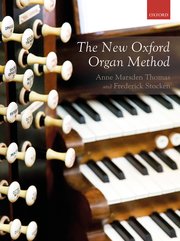New Oxford Organ Method
 Anne Marsden Thomas and Frederick Stocken
Anne Marsden Thomas and Frederick Stocken
ISBN 9780193518322
RRP £29.95 (our online price £28.45)
Thirty years after the publication of David Sanger's Play the Organ (Novello), the last publication of its kind to gain major market traction, The New Oxford Organ Method is an overdue and most welcome option for the beginning organ student.
Unlike the Sanger book, which is designed for complete keyboard beginners to learn directly at the organ, this new Oxford method assumes a certain level of keyboard competence prior to kick off - approximately equivalent to ABRSM Grade 2-3.
The authors' approach is to use selected repertoire pieces as the basis of individual chapters, building skills through appropriate studies and technical exercises. Chapter 6, for example, takes the F major Prelude from the 'Bach' 8 Short Preludes and Fugues, and has section headings on
- Balancing pedal and manual
- Measuring intervals between the feet
- Moving a 3rd with each toe
- Exchanging toes on a repeated note
- Duplets and triplets
- Hemiolas
- Notes of anticipation
- Coordinated releases on three staves
- Exposing sustained voices in a multi-voice texture
It's greatly encouraging that the first sub-section in 'Getting Started' after the paragraph about finding an instrument on which to practice, is headed 'Posture', followed by 'Bench' (height and position), 'Shoes' and 'Practice'. It's important to get the basics right, after all.
With a wealth of technical descriptions, illustrations, hints on historically-informed interpretation and registration, the New Oxford Organ Method presents a comprehensive approach to learning the organ, which can be used with or without the assistance of a teacher.
Indeed, the all-encompassing nature of the volume leads, perhaps, to its one drawback - its size and weight. At 279 pages it is not to be taken lightly but, for the serious student, the New Oxford Organ Method, which the blurb describes as 'an integrated course of study', is a remarkable addition to the OUP catalogue.
Compare the New Oxford Organ Method with these alternatives:
